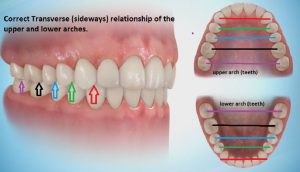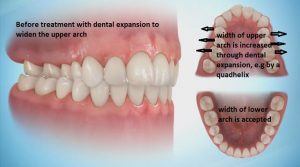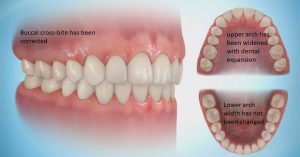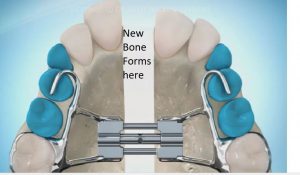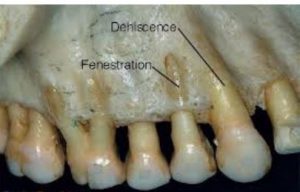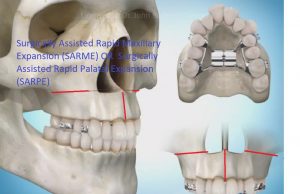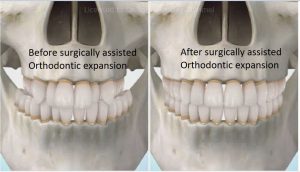We may be inclined to think of orthodontic treatment in terms of straightening the teeth and or adjusting the forwards- backwards relationship of the teeth.However in children and teenagers a very common orthodontic procedure is sideways expansion of the upper teeth. Expanders are used in orthodontics for the following reasons, to correct posterior crossbites, to provide space to reduce crowding,and to broaden the overall width of the arch. Sometimes in milder cases the archwire (the wire associated with fixed appliances (railway tracks)) will achieve the required amount of sideways expansion. In these circumstances no additional benefit is conferred (on the patient!) by overexpanding or by fitting an expander.
The correct or stable transverse (sideways) width of the upper arch is ultimately determined by the pre-existing width of the lower teeth. The width of the lower teeth can only be changed in general to a very minor extent. Many orthodontists have attempted to widen the width of the lower arch in the hope that they could achieve a similar expansion in the width of the upper arch. Unfortunately the results achieved in the lower arch tended to relapse back to their original position.
It is critically important to understand that the width of the lower arch determines the width of the upper arch, and the pre-existing width of the lower arch is largely un-changeable.
The famous actress Julia Roberts has a really wide smile, however she also has a pre-existing very wide lower arch, if she did not have a pre-existing wide lower arch, then she could not have a wide upper arch. Full stop end of discussion!! The width of her smile (whether you consider it to be attractive or not) is ultimately determined by her genes which determined the width of the lower arch. The width of the upper arch can then ( generally) be matched to the pre-existing (unchangeable) width of the lower arch with orthodontic treatment which corrects the width of the upper arch.
The remainder of this blog describes how the width of the upper arch is matched (expanded) to the pre-existing width of the lower arch. We have to accept that the width of the lower arch will determine the limit of stable expansion in the upper arch.
Expansion in orthodontics is broadly categorised into two types dental and skeletal. (There is however often a mixture of both dental and skeletal expansion when expanders are used.
Dental expansion
This is where the teeth are moved through the existing bone in the upper jaw the maxilla. The teeth move outwards through the existing bone. The width of the upper jaw bone is not widened. This maybe achieved with a removable expander or an appliance like a quadhelix.
Before dental expansion.
After dental expansion.
Note the teeth were moved sideways through the bone of the upper jaw, the width of the upper jaw itself was not increased.
Skeletal Expansions
The upper jaw or palate consists of 2 halves , the 2 halves are ultimately joined in the midline by a suture , the age at which the midpalatal suture fuses is highly variable, generally one is safe in assuming that it has not fused by 15 years of age.
In skeletal expansion of the upper jaw we move the 2 halves of the upper jaw apart (sideways) or transversely with for instance a hyrax appliance. The resulting gap between the two halves is filled in with new bone. This is how the bony width of the upper arch is increased. The front teeth initially move sideways with the two halves of the upper jaw and this creates a midline gap between the front teeth, while this is alarming, it closes of its own accord as the front teeth drift together into the newly formed bone across the midline gap. This gap shows that the upper jaw has separated along the midline.
This picture shows the palate separating into 2 halves, it is then held in this position while new bone forms and fills in the space where the two halves separated.
When does the midline suture of the palate fuse?
Research suggests that there is enormous variability as to the age at which the suture fuses , a rough rule of thumb is 15-16 years for girls and 17-18 years for boys. In girls who are less than 15-16 years old , and boys who are less than 17-18 years old,as the midline suture or growth plate is not closed, expanders will achieve skeletal expansion , that is an increase in the bony width of the upper jaw (palate).
After this age expansion will only be achieved by dental expansion, that is the teeth will move through the existing bone but no skeletal expansion will be achieved. This is confirmed by the fact that a gap will not appear between the upper front teeth. It is important to appreciate that there is a limit to the amount of sideways movement of the teeth through the existing bone or dental expansion. If excessive dental expansion is used , eventually the teeth could be pushed out through the bone giving rise to gingival recession, and dehiscences and fenestrations of the bone.
What if we require skeletal expansion in an adult?
Adults of course often require expansion , to correct posterior crossbites, to provide space to reduce crowding,and to broaden the overall width of the arch. Sometimes in milder cases the archwire (the wire associated with fixed appliances (railway tracks)) will achieve the required amount of sideways expansion. In these circumstances no additional benefit is conferred (on the patient!) by overexpanding or by fitting an expander. Sometimes dental expansion for instance with a quadhelix may provide sufficient expansion in an adult.
However in some adults dental expansion will not provide sufficient transverse or (sideways) expansion of the upper arch. In these circumstances surgically assisted orthodontic skeletal expansion maybe used, this procedure is referred to either as Surgically Assisted Rapid Palatal Expansion (SARPE) or Surgically Assisted Rapid Maxillary Expansion (SARME).
This procedure is performed by an oral and maxillo-facial surgeon , normally as a day stay procedure. It is all performed inside the mouth , therefore there are no visible scars. It involves making cuts through the side of the upper jaw bone above the top of the roots of the teeth, a cut is also made in the middle of the palate between the top of the upper front teeth. The patient then slowly expands the hyrax appliance until the necessary expansion has been achieved. Because this is skeletal expansion a gap will appear between the upper front teeth. This will close with time.
Orthodontic appliances e.g. braces are used to move the teeth into the desired position once sufficient width of the upper jaw has been achieved.
………………………………………………………………………………………………………………………………………………………….
(Clonmel Orthodontics blogs are intended to be factual rather than aspirational or for purely marketing purposes.)
This orthodontic blog was written by Dr John Buckley,who is a specialist orthodontist at Clonmel Orthodontics in Clonmel County Tipperary, Ireland.He is both Clonmel’s most qualified and most experienced orthodontist.
Clonmel Orthodontics provides orthodontics to county Tipperary and the neighbouring counties of Waterford, Kilkenny, Limerick,Cork , and beyond.
Dr Buckley has practised as a specialist orthodontist in Clonmel for over 20 years. In addition to his orthodontic qualifications which he held before he commenced orthodontic practice , Dr Buckley was awarded a First class masters degree in Lingual orthodontics from the University of Hannover medical school (MHH) in 2012. This masters degree is directed by Professor Dirk Wiechmann who is the inventor of both the incognito™ and win™ lingual appliances. Dr Buckley was the first orthodontist in Ireland to be awarded this qualification. In 2016 he was accepted as an active member of the European Society Of Lingual Orthodontics (ESLO). To become an active member it is necessary for candidates to submit the records of finished lingual cases. If the cases are deemed to be of a sufficiently high standard then the candidate is accepted as an active member of ESLO. Dr Buckley is the first and only orthodontist in Ireland to be accepted as an active member of ESLO.


